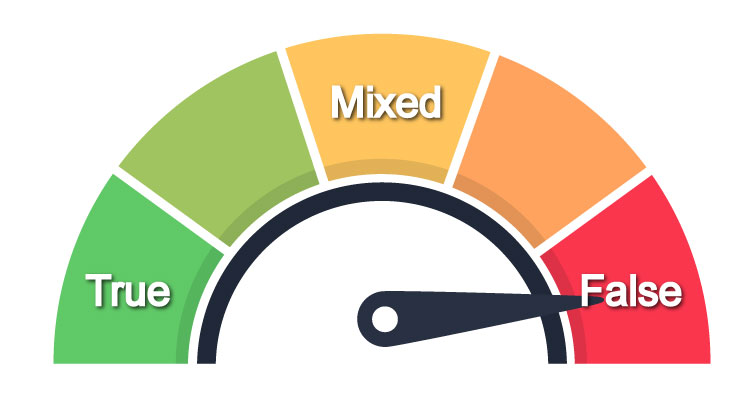Claim: “Asked why a business organization is leading the legal fight against proportional representation, Gardner said his organization fears it would be bad for the B.C. economy.”
Stated by: Chris Gardner, Independent Contractors and Business Association (ICBA), Vancouver Courier July 3 2018.
NOTE: The claim about the economy, when made by the ICBA, is usually paired with “instability” – read the Fact Check on stability here.

Fact Check
As a broad generalization about the economy, this claim is false.
Economics is a multi-faceted topic. The relationship between different aspects of economics and electoral systems is a complex topic subject to ongoing investigation with mixed findings.
There is certainly no consensus among researchers supporting a broad generalization that proportional representation is “bad for the economy.”
Here are a few notable findings in the research, dealing with economic growth (which would be central to the argument about electoral systems and economy, government spending, and deficits/surpluses/debts), illustrating the complexity of the issue:
Economic Growth
- Lijphart (2012) and Orellana (2014) found no relationship at all between electoral systems and economic growth.
- However, Knutsen (2011) looked at a much longer historical period involving 3,710 country-years of data covering 107 countries from 1820 to 2002. He found that proportional and semi-proportional systems produced an “astonishingly robust” and “quite substantial” increase in economic growth – a one percentage point increase – compared to plurality-majoritarian systems.
- Norris (2011, John F. Kennedy School of Government, Harvard), examining the relationship between different aspects of democratic institutions and economic growth concluded, “the direct effects of proportional representation electoral systems are also significantly related to income, further confirming Knutsen’s conclusions.”
- Alfano and Baraldi (2015) studied 91 countries from 1979–2010 and found a non-linear relationship between proportionality and rates of growth. The relationship appeared as a curve with the growth rate reaching its maximum value in correspondence with an intermediate degree of proportionality, corresponding to a Gallagher index about equal to 6.5. (Click here for information on the Gallagher Index, measuring disproportionality in elections. A Gallagher Index of 0 would be perfectly proportional – the higher the score, the more disproportional the results. Click here for Gallagher scores for different countries. A score of 6.5 – associated with the highest level of economic growth – is a similar level of proportionality to Scotland and Ireland, which use Mixed Member Proportional and Single Transferable Vote with local regions/districts – proportionality combined with local representation).
- They find the predicted economic growth rate for highly disproportional systems drops sharply into the negative territory for a Gallagher Index above about 14. They argue that:
…in systems with an intermediate degree of proportionality, the beneficial accountability characteristics of plurality/majoritarian systems (which may induce office-motivated politicians to enact growth-promoting policies) are put beside the beneficial representativeness characteristics of PR (which induce politicians to enact public policies that benefit broad rather than narrow interests). Secondly, a mixed method enhances both political and government stability stimulating a relatively high growth rate.
Economic Stability
- Nooruddin’s (2011) study of economic volatility and electoral systems found that coalition governments produced less economic volatility due to more stable economic policy. He notes that:
When a single party controls all the levers of the legislative process, it is better able to enact policies closer to its ideal point. The resulting policy might in fact be the preferred outcome for economic agents too (for instance, if the government in question favors a business-friendly policy regime), but the government can not guarantee that future governments will not reverse course should the opposition win. In this case, even if economic agents respond by investing in the country, they will remain wary of future policy change, and therefore forgo more irreversible investments.
Using cross-national time-series data from over 100 developing countries, that even after controlling for plausible alternative political factors and for theoretically-relevant economic factors, coalition governments in parliamentary democracies have higher growth rates than other forms of government, and such governments experience lower growth-rate volatility.
Government Spending
- Most researchers agree that countries with proportional representation spend more on average on social expenditures as a percentage of GDP (social programs, education, pensions etc). For example, Lijphart (2012) found that countries with PR spent an average of 4.75% more on social expenditures than majoritarian democracies.
- Orellana (2014) found the countries with proportional representation spend less on military expenditures.
Researchers cited by both opponents and proponents agree that single-member districts and plurality vote (winner-take-all-systems) both tend to pull in the direction of narrowly targeted programs benefiting small geographic constituencies. Conversely, multi-member districts and proportional representation induce politicians to provide benefits for broad groups of voters. Building on this insight, some recent papers have studied the influence of district magnitude and the electoral formula on the composition of government spending. Here is how Perssons and Tebellini put it (2008):
Multi-member districts and proportional representation diffuse electoral competition, giving the parties strong incentives to seek electoral support from broad coalitions in the population through general public goods or universalistic redistributive programs (e.g., public pensions or other welfare programs). In contrast, single-member districts and plurality rule typically make each party a sure winner in some of the districts, concentrating electoral competition in the other pivotal districts. Both parties thus have a strong incentive to target voters in these swing districts.
- Reinforcing the findings of more redistribution in countries with proportional representation, multiple researchers (Birchfield, Vicki and Crepaz, Markus (1998), Iversen, T., & Soskice, D. (2006), Lijphart (2012), have found lower levels of income inequality in countries with proportional systems.
- It is important to note that unlike many of the List PR systems in Europe (most of the OECD), the proportional models proposed for BC all retain local MLAs elected by voters in specific ridings and regions. They do not include any MLAs accountable only to voters in the province as a whole. Thus the incentives for parties to target spending locally would be expected to continue.
- Research by Persson and Tabellini – summarized by Clemens and Jackson for the Fraser Institute – and by Perotti, Rostagno and Milesi-Ferretti (2001) found that countries with proportional systems had higher government spending overall (not just on social expenditures).
- Milessi-Ferretti, Perotti and Rostagno (2002) summarize their research findings as follows:
We presented a theoretical model in which voters anticipating government policymaking under different electoral systems have an incentive to elect representatives more prone to transfer (public good) spending in proportional systems. The model also predicts higher total primary spending in proportional (majoritarian) systems when the share of transfer spending is high. To test our predictions, we have defined and constructed rigorous measures of proportionality that take into account the existence of different voting methods, multiple electoral tiers, and electoral thresholds. In the empirical investigation, we have found strong support for our predictions in OECD countries.
- Carey and Hix (2010) has suggested the research by Perssons and Tabellini and Clemens and Jackson fails to accurately distinguish between types of electoral systems or degrees of proportionality. They produce more nuanced conclusions (see below, under “deficits, debts and surpluses”), showing that countries with moderately proportional systems outperform both majoritarian and highly proportional systems.
- There is currently little difference in overall spending between OECD countries using proportional and majoritarian systems.
Deficits, Debts and Surpluses
- Research summarized by Clemens and Jackson for the Fraser Institute, including the work of Grilli, Masciandaro and Tabellini (1991) and Perssons and Tabellini (2003) finds higher deficits and debt in countries with proportional systems.
- Research by Orellana (2014) finds that “countries with more proportional electoral systems and more diverse party systems may actually tend to have lower budget deficits (higher surpluses) than countries with first-past-the-post systems and less diverse party systems.” Orellana also finds that the projected national debt is 65.7 percent higher in majoritarian countries than in those with fully proportional systems.
- According to Orellana, the flaw in Perssons and Tabellini’s research is in determining which countries use which type of electoral system. For example, Greece, an extreme outlier with a very large debt load, is classified by Perssons and Tabellini with the countries using proportional systems, when Greece’s system functions closer to a majoritarian system, producing disproportional results by giving the party with the most seats a 50 seat bonus.
- Carey and Hix (2010, London School of Economics) found that “low magnitude” proportional systems (with an average number of seats per region between 5 and 9) did better than both majoritarian and highly proportional systems. As they observe,
To the extent that we found any differences between single member district systems and low district magnitude PR systems, the latter did better on spending, deficits, and scores on the United Nations Index of Human Development.
- Carey and Hix underscore the importance of examining the degree of proportionality, observing that,
Any improvements in low-district magnitude PR systems, relative to single member (majoritarian) systems, go away (and are even reversed) at higher district magnitude levels, which is why Persson and Tabellini (the research cited by the Fraser Institute) find the results they do when they test only linear models.
References
Birchfield, Vicki and Crepaz, Markus (1998). “The Impact of Constitutional Structures and Collective and Competitive Veto Points on Income Inequality in Industrialized Democracies.” European Journal of Political Research 34: 175-200.
Carey, John M. and Hix, Simon (2009). “The Electoral Sweet Spot: Low-magnitude Proportional Electoral Systems. PSPE Working Paper 01-2009. Department of Government, London School of Economics and Political Science, London, UK
Jason Clemens, Taylor Jackson, Steve LaFleur, and Joel Emes (2016). Electoral Rules and Fiscal Policy Outcomes. For the Fraser Institute: https://www.fraserinstitute.org/sites/default/files/electoral-rules-and-fiscal-policy-outcomes.pdf
Alfano, M. & Baraldi, A. (2015). Proportional Degree of Electoral Systems Growth: A Panel Test. Rev. Law Econ. 2015; 11(1): 51–78.
Iversen, T., & Soskice, D. (2006). “Electoral Systems and the Politics of Coalitions: Why Some Democracies Redistribute More Than Others. American Political Science Review 100-2: 165–81.
Knutsen, Carl (2011). “Which Democracies Prosper? Electoral Rules, Forms of Government, and Economic Growth.” Electoral Studies 30: 83-90.
Lijphart, Arend (2012). Patterns of Democracy. Government Forms and Performance in 36 Countries. New Haven, CT: Yale Press.
Nooruddin, Irfun (2011). Coalition Politics and Economic Development. Credibility and the Strength of Weak Governments. Cambridge University Press.
Norris, Pippa (2011). Making Democratic-Governance Work: The Consequences for Prosperity. HKS Faculty Research Working Paper Series RWP11-035, John F. Kennedy School of Government, Harvard University.
Orellana, Saloman (2014). Electoral Systems and Governance: How Diversity Can Improve Policy Making. New York: Routledge Press.
Persson, Torsten and Tabellini, Guido (2008). Electoral Systems and Economic Policy. In the Oxford Handbook of Political Economy, Oxford University Press.
Roberto Perotti ; Massimo V. Rostagno ; Gian M Milesi-Ferretti. (2001). Electoral Systems and Public Spending. IMF Working Papers.
